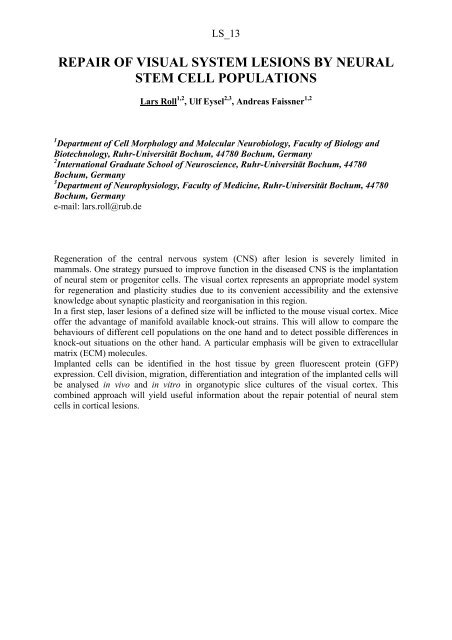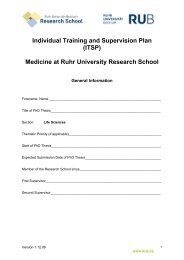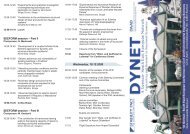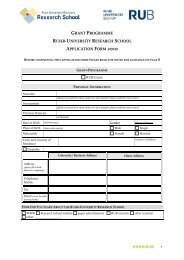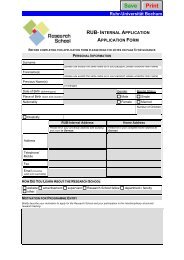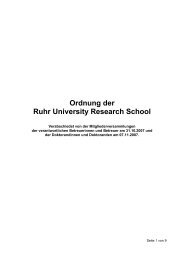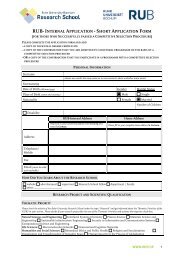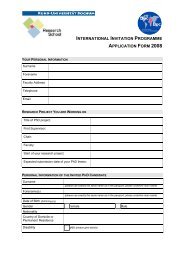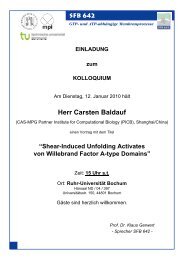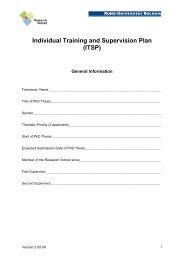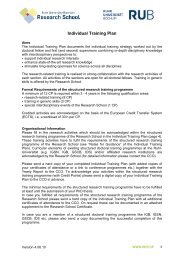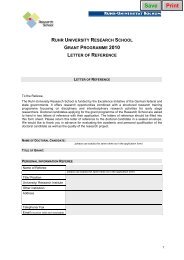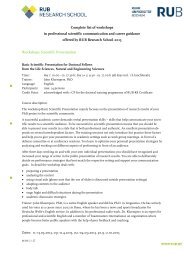Section Days abstract book 2010.indd - RUB Research School ...
Section Days abstract book 2010.indd - RUB Research School ...
Section Days abstract book 2010.indd - RUB Research School ...
Create successful ePaper yourself
Turn your PDF publications into a flip-book with our unique Google optimized e-Paper software.
LS_13<br />
REPAIR OF VISUAL SYSTEM LESIONS BY NEURAL<br />
STEM CELL POPULATIONS<br />
Lars Roll 1,2 , Ulf Eysel 2,3 , Andreas Faissner 1,2<br />
1<br />
Department of Cell Morphology and Molecular Neurobiology, Faculty of Biology and<br />
Biotechnology, Ruhr-Universität Bochum, 44780 Bochum, Germany<br />
2<br />
International Graduate <strong>School</strong> of Neuroscience, Ruhr-Universität Bochum, 44780<br />
Bochum, Germany<br />
3<br />
Department of Neurophysiology, Faculty of Medicine, Ruhr-Universität Bochum, 44780<br />
Bochum, Germany<br />
e-mail: lars.roll@rub.de<br />
Regeneration of the central nervous system (CNS) after lesion is severely limited in<br />
mammals. One strategy pursued to improve function in the diseased CNS is the implantation<br />
of neural stem or progenitor cells. The visual cortex represents an appropriate model system<br />
for regeneration and plasticity studies due to its convenient accessibility and the extensive<br />
knowledge about synaptic plasticity and reorganisation in this region.<br />
In a first step, laser lesions of a defined size will be inflicted to the mouse visual cortex. Mice<br />
offer the advantage of manifold available knock-out strains. This will allow to compare the<br />
behaviours of different cell populations on the one hand and to detect possible differences in<br />
knock-out situations on the other hand. A particular emphasis will be given to extracellular<br />
matrix (ECM) molecules.<br />
Implanted cells can be identified in the host tissue by green fluorescent protein (GFP)<br />
expression. Cell division, migration, differentiation and integration of the implanted cells will<br />
be analysed in vivo and in vitro in organotypic slice cultures of the visual cortex. This<br />
combined approach will yield useful information about the repair potential of neural stem<br />
cells in cortical lesions.


